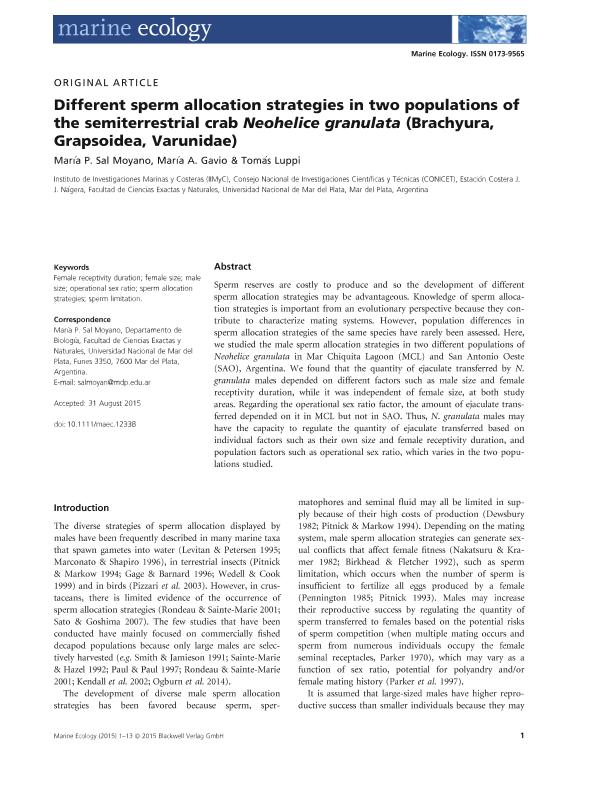Artículo
Different sperm allocation strategies in two populations of the semiterrestrial crab Neohelice granulata (Brachyura, Grapsoidea, Varunidae)
Fecha de publicación:
08/2016
Editorial:
Wiley Blackwell Publishing, Inc
Revista:
Marine Ecology-pubblicazioni Della Stazione Zoologica Di Napoli I
ISSN:
0173-9565
Idioma:
Inglés
Tipo de recurso:
Artículo publicado
Clasificación temática:
Resumen
Sperm reserves are costly to produce and so the development of different sperm allocation strategies may be advantageous. Knowledge of sperm allocation strategies is important from an evolutionary perspective because they contribute to characterize mating systems. However, population differences in sperm allocation strategies of the same species have rarely been assessed. Here, we studied the male sperm allocation strategies in two different populations of Neohelice granulata in Mar Chiquita Lagoon (MCL) and San Antonio Oeste (SAO), Argentina. We found that the quantity of ejaculate transferred by N. granulata males depended on different factors such as male size and female receptivity duration, while it was independent of female size, at both study areas. Regarding the operational sex ratio factor, the amount of ejaculate transferred depended on it in MCL but not in SAO. Thus, N. granulata males may have the capacity to regulate the quantity of ejaculate transferred based on individual factors such as their own size and female receptivity duration, and population factors such as operational sex ratio, which varies in the two populations studied.
Archivos asociados
Licencia
Identificadores
Colecciones
Articulos(IIMYC)
Articulos de INSTITUTO DE INVESTIGACIONES MARINAS Y COSTERAS
Articulos de INSTITUTO DE INVESTIGACIONES MARINAS Y COSTERAS
Citación
Sal Moyano, María Paz; Gavio, Maria Andrea; Luppi, Tomas Atilio; Different sperm allocation strategies in two populations of the semiterrestrial crab Neohelice granulata (Brachyura, Grapsoidea, Varunidae); Wiley Blackwell Publishing, Inc; Marine Ecology-pubblicazioni Della Stazione Zoologica Di Napoli I; 37; 4; 8-2016; 737-749
Compartir
Altmétricas




